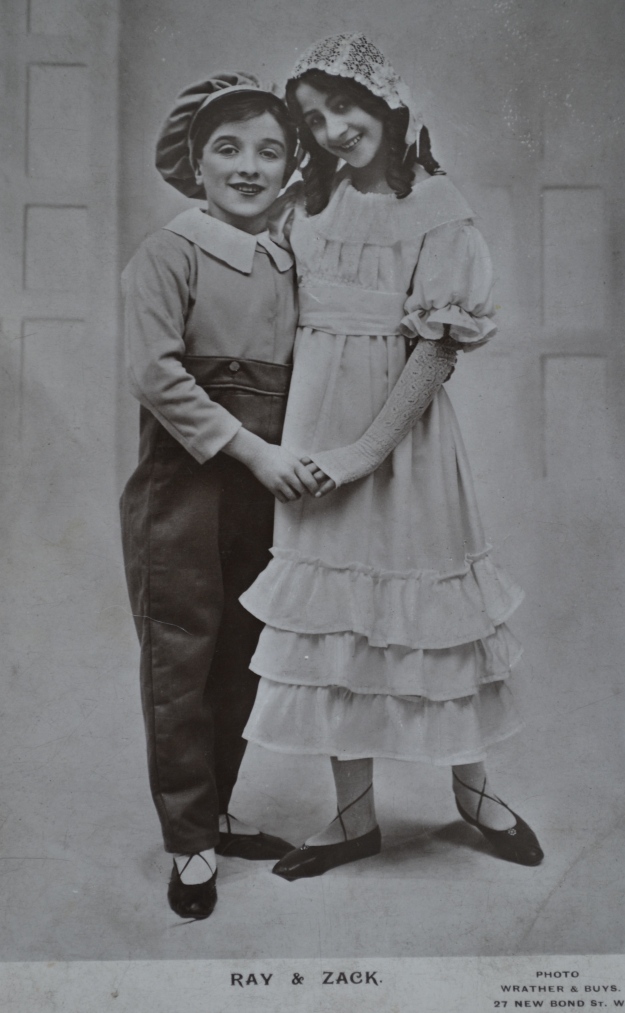
Leo King in a studio photograph taken to promote his music hall act, probably 1913 – 1918. (c) Emma King.
This is my grandad, Leo King. It was taken sometime in the 1910s in Liverpool when Leo was beginning his career in music hall. Born in 1899 or thereabouts, Leo died in 1956, long before I was born. I know very little about him as my dad, an only child, was only nine when Leo died and his memories of his father were dim. However, we have a small box of photos and memorabilia that belonged to Leo and for a long time now I’ve been trying to piece together some information about his life.
The most fascinating of Leo’s effects is an autograph book from his music hall days. It’s very tattered and fragile, testament to years of use. The autograph book is mentioned in an obituary of Leo from the Yorkshire Post newspaper in 1956 – apparently he loved to reminisce about his time in the limelight and would show the autograph book to anyone who asked to see it (and, I imagine, probably many who didn’t). In it there are postcards, drawings, photos and autographs from many of the people he shared the bill with, including a signed photo of Marie Lloyd from July 1914; one from 1918 of George Formby, father of the more famous ukulele-playing namesake; a dedication from the double act Naughton and Gold; and a dedication from Doris Waters, better known as one half of the comedy duo Gert and Daisy.
Leo had his own act under the name Leo Ray. According to my grandmother, he played the trombone on roller skates. Grandma was 20 years younger than Leo and married him in the 1940s so would never have seen the act herself, but somewhere we do have a photograph of Leo with a trombone advertising an act called ‘Trombone, Troubles and Trials’. He also had a double act with a female performer. They called themselves ‘Ray and Zack’ and I have no idea what their act involved but from what I’ve gleaned from newspaper reviews, they were typical variety performers of the era. They were also regulars in pantomime. Leo was small – only four feet eleven inches tall, according to his records from the Royal Air Force in 1918 – so I guess was a natural for the role of one of the lost children in ‘Babes in the Wood’.

Studio postcard of Ray & Zack. Image (c) Emma King
I’m gradually trying to piece together a list of Leo’s musical engagements gleaned from the few dated entries in his autograph book and from newspaper reviews via the British Newspaper Archives. The first reviews I can find were from late 1913, when Leo would have been 14 or 15 years old, and the last are from 1918. Leo joined the Royal Air Force in June 1918 and was sent to France to act as a ‘batman’ for one of the officers, which seems to have put an end to his career in music hall as I can’t find any evidence of him continuing after that date. Despite the brevity of his career there are some lovely reviews such as this one from the Manchester Evening News on 24 March 1914:
“The contribution which gives most pleasure to the audience is made by two very young and comparatively unknown performers, styled Ray and Zack. The ranks of the music hall artists have not been reinforced by two more promising performers for many years past. Before they sing a note or dance a step, it is evident from the originality and tastefulness of their costumes that they are no mere tiresome prodigies, and as a matter of fact they are as entertaining as they are quaint, and as joyous as they are versatile”.
I still have many questions about Leo’s music hall life. One is to find the identity of Zack. The most likely candidate seems to be Gertie Zacklin, a music hall performer from the 1920s and 30s who called herself Ray Zack and married the comedian and producer Tommy Mostol. Gertie was born in about 1900 in Leeds so was a similar age to Leo, though it’s impossible to know how they might have met. The stage name seems too much of a coincidence, and given that Leo had given up his act by the end of the First World War it’s entirely plausible that his partner from the Ray and Zack double act should have adopted the name. Both Ray Zack and Tommy Mostol sighed Leo’s autograph book in the 1930s. There is a 1930 sketch featuring Ray Zack and Tommy Mostol on the British Pathe website.
My other burning question was how on earth Leo got started in music hall in the first place. He was born into a military family in Aldershot; in 1901 his father worked in the ordnance stores there and there’s no suggestion that anyone else in the family had musical employment. I’ll explore that question further in my next post.




